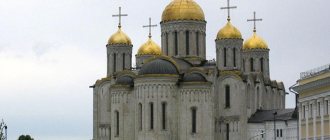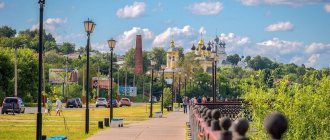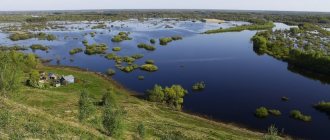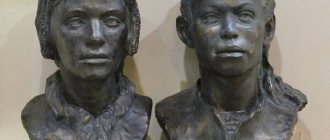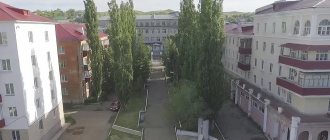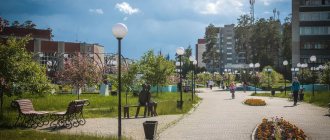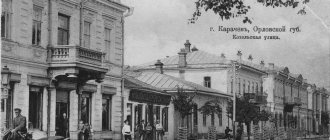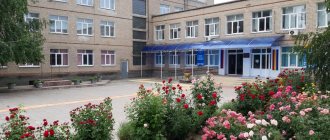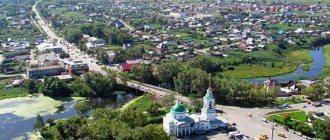↑ History of Lakinsk
The city of Lakins is the legal successor of the village of Undol. The village was rich, as it was located on an important road from Vladimir to Moscow. The first mention of the place dates back to the 15th century. Soon the place was nicknamed “the sad valley.” The fact was that convicts who were moving east from the western part of Russia made a stop here. Lakinsk is famous for the fact that the village of Undol has been the estate of the Suvorov family since the 17th century. The great commander Alexander Vasilyevich often visited here.
At the end of the 19th century, the Bazhanov merchants opened a weaving factory here. The factory gave the town new life, and farm and residential buildings began to appear around it. The place, which became a new force of attraction, was popularly called Bazhanovka. In 1917, a revolution occurred in Russia and the Civil War began. The new government imposed its own rules, culture, renamed factories and streets in a new way.
The factory of the Bazhanov merchants began to bear the name of the revolutionary Lakin, who was killed here in 1905. The factory developed, and soon the place received the status of a workers' village of Lakinsky. In the middle of the 20th century, after the end of the Great Patriotic War, new lands became part of the village: Undol, Alekseevka, Bykovka, lands of factories and military units. A few years later, in 1969, the village received city status.
The commercial and industrial village of Undol, known since the end of the 15th century, located on the river of the same name (now Undolka), entered the boundaries of Lakinsk. In the 16th-18th centuries, the village was part of the Krisinsky volost of the Vladimir district of the Zamoskovsky region of the Moscow kingdom. The Church of the Resurrection of Christ was located in the village. The village was the patrimony of the boyar Semyon Vasilyevich Golovin, then his relatives. In 1781, the village of Undol belonged to Alexander Vasilyevich Suvorov.
The hydronym is clearly of pre-Russian origin, but folk legend connects the name Undol with Vladimirka, which passed through the village. The convicts made a halt here, as a result of which this place was nicknamed “the sad valley.” Subsequently, Dismal Valley was shortened to Undol. In the 18th century, the estate of the Suvorov family was located in Undol; Alexander Vasilyevich Suvorov lived here in 1784-1786.
In 1889, a weaving factory of the Bazhanov merchants was opened near the village. In fact, there was a transfer of production, founded in the middle of the 19th century, to the village of Undol due to the proximity of the railway station. At first, the factory and buildings near it were called Bazhanovka. In 1922, the factory was named after Lakin, who was killed in Undol in 1905.
With the development of the factory, the working settlement of Lakinsky was formed (the settlement officially received this status in 1927). In April 1965, the village of Undol and the small villages of Alekseevka, Bykovka, Military Unit No. 74100, the Brick Factory, the Sobinsky Automobile Facility, the Sobinsk Machine-Reclamation Station and the village at the Undol station were included in the working village of Lakinsky. In 1969, the village of Lakinsky was given city status.
The city's attractions
One of the attractions of the city of Lakinsk is the church built in 1693 and preserved to this day in honor of the icon of the Kazan Mother of God, which is an architectural and historical monument included in the list of monuments of the region.
In 1693, through the zeal of the landowner, steward Pyotr Vasilyevich Golovin, the Kazan Church was built in Undol. According to local legend, the place for the construction of the temple was chosen by the Mother of God herself. The Kazan Icon of the Mother of God appeared twice at the source. It was decided to build a new stone temple near the source.
In the 1780s, the owner of the village, the great commander Alexander Vasilyevich Suvorov, added a warm chapel to the temple of St. Sergius of Radonezh. In 1859, a warm meal with the throne of St. Nicholas the Wonderworker and a bell tower were built using church funds. In 1870, also using church funds, the church and bell tower were surrounded by a stone fence.
In Soviet times, the temple was closed. Its premises were converted into an auto repair shop. The pre-revolutionary decoration of the temple has not been preserved, but, fortunately, the entire architectural ensemble was not damaged. The Kazan Church was restored in the 1990s.
Nowadays, on holidays, many pilgrims flock to the church to fall at the healing spring and thank the temple’s miraculous icon for healing and strengthening. Since ancient times, the Kazan Icon of the Mother of God saved people from blindness and endowed them with spiritual insight.
In the park opposite the Lakin factory there is a monument to M.I. Lakin (1876-1905), revolutionary. At the end of November 1905 M.I. Lakin came to Undol to create a Social Democratic circle at the factory. On the night of November 28-29, 1905, he was killed by the Black Hundreds.
On the street also named by him. Lakin, a memorial stone was erected at the site of his death.
The sculptural composition “Transfer of the Olympic Flame” was installed in memory of the VI World Festival of Youth and Students.
On the central square there is a monument to V.I. Lenin.
On the street Gorky there is a monument to the outstanding writer Maxim Gorky
In the center of the city there is a memorial complex “Eternal Flame” in memory of the soldiers who died during the Great Patriotic War. The memorial is surrounded by blue fir trees - symbols of bravery, loyalty, boldness, and fearlessness. 863 names of Lakinians who did not return from the battlefields are immortalized on memorial plaques.
Based on the “eternal flame” the following words can be read: “For the sake of life on earth. Be worthy of the memory of the fallen. We survived and won . The “eternal flame” always burns here.
Many famous people were born or lived in the city of Lakinsk.
| In 1775, Alexander Vasilyevich Suvorov inherited an estate in Undol from his father, in which he lived for many years. In 1784, after Suvorov became commander of the 6th Vladimir Division, Alexander Vasilyevich lived in Undol permanently for two years. A large trading village on the Moscow road, where not only he himself, but also the headquarters of the Vladimir division could be located, the village of Undol was not chosen by Suvorov by chance. Special barracks were built here for the soldiers, “dry, bug-free,” to save the peasants from the hardships of standing. Suvorov himself lived in a small manor house located above the Undolka River. It was here that he wrote his famous treatise “The Science of Victory.” |
| Vukol Mikhailovich Undolsky - bibliographer and bibliophile was born on January 13, 1816 in the village of Undol, Vladimir district, in the family of sexton Mikhail Pankratovich Annensky and his wife Ksenia Vasilievna. A bibliographer and collector of monuments of ancient Russian literature, he served in the archives of the Ministry of Justice, and was a librarian at the Society of Russian History and Antiquities. A passionate lover and great connoisseur of antiquities, Undolsky set himself the task of compiling a collection that would combine the fullest possible range of materials for scientific work in all branches of ancient Russian history and literature. |
| In 1898, he was transferred from service to the Undol station of the Moscow-Nizhny Novgorod Railway to the position of commodity cashier Matvey Ivanovich Ozhegov, which he held in 1899. He lived in the village of Alekseevka, Kochukovsky volost, Vladimir district (now part of the city of Lakinsk). In December 1898, the aspiring self-taught poet I.A. came here to Ozhegov for a week from Suzdal. Nazarov. Matvey Ozhegov wrote poems for such famous songs as “I Lost a Ring”, “Between Steep Banks” and “A Wonderful Moon Floats Over the River”. |
| TSEKHANSKY Andrey Andreevich (11/30/1893) - founder and director of the amateur theater club of the Faculty of Arts named after. Lakina, Honored Artist of the RSFSR (1959). During the Great Patriotic War, a propaganda brigade was created on the basis of the theater, which made about 100 trips, giving concerts at recruiting stations, in military units, hospitals, and at the front. For more than 30 years of leading the theater group, A.A. Tsekhansky staged more than 100 performances based on plays by Russian, Soviet and foreign authors. In 1962, for the play “Irkutsk History” by A. Arbuzov, the drama group was awarded the first prize of the Regional Review Commission and was awarded the honorary title of the People's Theater. |
Date created: 08-06-2020 Date last modified: 08-06-2020
↑ Industry and economy of Lakinsk
Lakinsk is actively developing as an industrial satellite of Vladimir. The city is famous for its brewery, which in addition to beer produces soft carbonated drinks under various brands. The plant's products are popular not only in the Vladimir region. There is its own milk, furniture factory "Lakinsk-mebel", snacks are made at the production of Klin Snacks LLC and bread supplies the city's needs for bakery products.
It is worth paying special attention. This is a joint Russian-Dutch enterprise, which is a market leader in the production of animal feed and premixes. The company was opened in 2009. Since then, the company has been providing its products not only to the entire region, but also to the regions of the Central Federal District. The plant's capacity for the production of premixes is 120 thousand tons per year, the capacity of the prestarter plant is 30 thousand tons per year. The plant employs more than 250 people.
The city of Lakinsk was left without a city manager
Photo from Zebra TV archive
On Thursday, February 3, the Council of People's Deputies of the city of Lakinsk agreed on the early resignation of city manager Alexei Andrianov. This information was confirmed to Zebra TV by the deputy head of the city administration, Natalya Nikolaeva. Now she is acting as head of the mayor's office.
Alexey Andrianov headed the administration of the city of Lakinsk in November 2018. To achieve this, the local city council even softened the requirements for candidates for city managers, reducing the length of municipal service required to work in the position from 6 to 4 years.
Shortly before his appointment, Andrianov, a member of the regional political council of United Russia, was defeated in the elections of deputies to the Legislative Assembly of the Vladimir region in single-mandate district No. 2, which includes the Kirzhach and Aleksandrovsky districts.
According to Tomix sources, Alexey Andrianov may become the head of the administration of the Kolchuginsky district, where a competitive selection of candidates for this position was recently announced. Andrianov, as a publication, has already allegedly visited the district administration and “did not make a positive impression.”
Tomix notes that Andrianov comes to the Kolchuginsky district against the backdrop of a conflict in the local United Russia cell. The publication claims that the appearance in open sources of information that the previous head of the district administration, Konstantin Mochalov, was deprived of his license for drunk driving is one of the episodes of internal confrontation. Because of this scandal, Mochalov had to resign.
Zebra TV was unable to confirm or deny information about the upcoming appointment of Alexey Andrianov as head of the Kolchuginsky district administration. United Russia itself did not respond to calls and messages from the editors. It is also unknown who will become the new city manager of Lakinsk.
UPD 15:30
Alexey Andrianov was appointed acting head of the Kolchuginsky district administration. The publication “Voice of Kolchuginets” that on Friday, February 4, the acting first deputy governor of the Vladimir region, Alexander Remiga, introduced Andrianov to the deputies of the district council as “a person with extensive experience”:
“He has already worked in business and in the municipal service. You know him as the head of Lakinsk. He has established himself as a diplomatic person and at the same time a professional business executive. It is known that these two qualities do not often coexist in people. Nevertheless, Alexey Yuryevich has them. He established calm business relations with Lakinsk businessmen, with the residents of this city, with investors. Thanks to his initiative and energy, a number of problematic issues for Lakinsk were resolved. I am confident that a person with such positive energy, charged with success, will bring significant benefits to the Kolchugino region.”
Alexey Andrianov himself, speaking before the Kolchuginsky district council, stated that he did not consider his position to be political. The new district manager is convinced that he will “have constructive interaction” with local deputies. Members of the Council of People's Deputies supported Andrianov's candidacy unanimously, Fr.
The brightest events of the day are in .
↑ Interesting facts
- Lakinsk is rightfully considered the small homeland of Alexander Suvorov. He lived on an Undol estate, which he later inherited from his father. On the estate he maintained a serf theater and built a school for children.
- The city owes its modern name to the revolutionary Mikhail Ignatievich Lakin. Lakin came to Undol in order to create a social democratic circle at a local factory. But his endeavors were not destined to come true; the revolutionary was killed by the Black Hundreds.
- The famous collector of monuments of Slavic writing, Vukol Mikhailovich Undolsky, was a native of Lakinsk.
- The poet Matvey Ivanovich Ozhego worked for some time as a cashier at the local railway station.
Industry
- The leading enterprise in the city is the Lakinskaya Manufactory spinning and weaving factory (cotton fabrics and yarn). At the moment, the company is declared bankrupt.
The founding date of the factory is considered to be February 3, 1889, when the Vladimir provincial government gave permission for its construction. On November 6, 1922, the Undol weaving factory of the Bazhanov brothers was named after Mikhail Ignatievich Lakin. In January 1927, the first spinning mill under Soviet power was launched, which was attended by Valerian Vladimirovich Kuibyshev. On January 24, 1944, the spinning and weaving factory was awarded the Order of the Red Banner of Labor. In 1992, the factory was reorganized into JSC Undolskaya Manufactory, which was declared bankrupt two years later. In September 1998, the bankruptcy manager of the factory, Lev Fadeychev, created the Lakinskaya Manufactory municipal enterprise.
- Klinskiye Sneks LLC is a food manufacturer.
- OJSC "Lakinskoye Milk" - processing of milk and dairy products.
- Furniture factory "Lakinsk-furniture".
- Poultry farming association "Vladzernoprodukt".
- Lakinsky production enterprise - production of “Lakinsky beer”, “Undolskaya” mineral water, carbonated drinks and kvass.
- LLC "VAN" - production of soft and carbonated drinks.
- — production of vermicelli and instant noodles.
- LLC "Press" - production of baking mixtures commissioned by JSC "Dalnyaya Melnitsa" (Moscow).
- JSC "De Heus" - production of premixes and pre-starter feed for piglets.
↑ Sights of Lakinsk
Lakinsk is a small town, but, like any provincial town, it has its own flavor and charm. Here you can see monuments to the Soviet past - Lenin, Gorky, and the revolutionary Lakin. There is a monument dedicated to the 1980 Olympic Games in Moscow - the sculpture is called “Transfer of the Olympic Flame.”
The Church of the Kazan Icon of the Mother of God deserves special attention from the traveler. The history of the temple began in 1693. Later, by order of Suvorov, a warm chapel, a refectory and a bell tower were added to the small wooden church. After the revolution, the temple was closed and turned into a car repair shop. In the 90s of the 20th century, the church began to be restored.
Lakinsk. A sad valley and the best beer.
Lakinsk is a small town on the Vladimir highway, 120 kilometers from Moscow. At the entrance there is a village with the sonorous name Undol (of course, of non-Russian origin, although the convicts who walked along this road “far, far beyond Baikal” called it among themselves Dull Valley), and the Kazan Church (1693) remained from the Suvorovs’ estate, where Alexander Vasilich himself, the conqueror of Izmail and the Alpine passes, lived here in 1784-85. But apart from the church, nothing has survived:
In its vicinity there are several houses, most likely built by peasants who succeeded in roadside trade.
Ahead, behind the trucks traveling to some distant distance and the deep valley of Undolka, rises a textile factory, founded in 1889 by the Bazhanov merchants. Please note that the route passes through the city, but not a single building is located on its “red line”:
The appearance of the factory buildings is unusual, some kind of transition from Art Nouveau to Constructivism, and indeed the factory was built in 1923-27. Such a large construction project at the dawn of the five-year plans is not an ordinary event, and Kuibyshev personally opened the new factory:
Before the revolution, the village near her was called Bazhanovka, and the town of Lakinskoye became the same in 1927 in honor of the local activist Mikhail Lakin, who was killed by the Black Hundreds in 1905.
Lakinsk (Vladimir region)
Panorama of the city of Lakinska from Undolskaya mountain.
City of Lakinsk . As a matter of fact, it became a city quite recently - in 1969. Before this, the settlement was called differently: the village named after. M.I. Lakina. The spinning and weaving factory around which the city grew up bears the same name. Who was the person whose memory the people decided to immortalize in names?
Administrative and municipal status[edit]
As part of the administrative-territorial division, Lakinsk is directly subordinate to the Sobinsky district. [1] As a municipal division, the city of Lakinsk is included within the Sobinsky Municipal District as the Lakinsk urban settlement
. [4]
Notes[edit]
- ^ abcd Resolution No. 433
- ^ a b Federal State Statistics Service (2011). All-Russian Population Census 2010. Volume 1 [All-Russian Population Census 2010, vol. 1]. All-Russian Population Census 2010 [All-Russian Population Census 2010] (in Russian). Federal State Statistics Service.
- "26. The size of the permanent population of the Russian Federation by municipalities as of January 1, 2022". Federal State Statistics Service. Retrieved January 23, 2022.
- ^ abcd Law No. 38-OZ
- "On the Calculation of Time". Official Internet portal of legal information
. June 3, 2011. Retrieved January 19, 2022. - Post office. Information and computing center of OASU RPO. ( Post office
).
Search for postal service objects ( postal Search for objects
) (in Russian) - ↑
Federal State Statistics Service of Russia (May 21, 2004). The population of the Russian Federation as part of federal districts, urban settlements, settlements, settlements, settlements, settlements, settlements, settlements, settlements, settlements, settlements settlements, settlements, settlements, settlements.[Population of Russia, its federal districts, constituent entities of the Federation, districts, urban settlements, rural settlements - administrative centers and rural settlements with a population of more than 3000 people] (XLS). All-Russian Population Census of 2002 [All-Russian Population Census of 2002] (in Russian). - All-Union Population Census of 1989 Population of Union and Autonomous Republics, Autonomous Regions and Districts, Territories, Regions, Urban Settlements and Village District Centers [All-Union Population Census of 1989: Current Population of Union and Autonomous Republics, Autonomous Regions and Districts, Territories, Regions , districts, urban settlements and villages performing the functions of district administrative centers]. All-Union Population Census of 1989 [All-Union Population Census of 1989] (in Russian). Institute of Demography of the National Research University: Higher School of Economics [Institute of Demography of the National Research University: Higher School of Economics]. 1989 - via Demoscope Weekly
.
